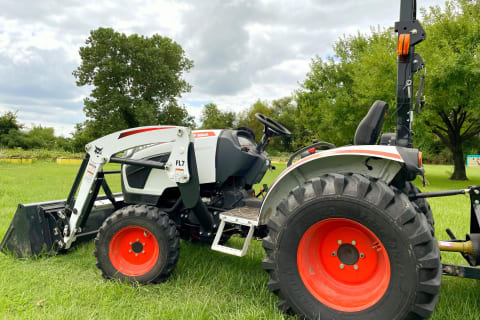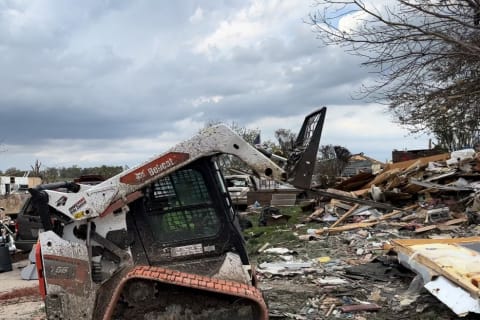- Home
- Company
- News & Media
- Bobcat Stories
- California Contractor Brings Life Back to Fire-Ravaged Santa Rosa Using Bobcat Equipment
California Contractor Brings Life Back to Fire-Ravaged Santa Rosa Using Bobcat Equipment
Published on September 10, 2018
What started out as a small flame, quickly became a raging fire, leaping and igniting more than a dozen new fires across Napa, Santa Rosa and Sonoma, California. Soon, wine country – one of the most popular tourist attractions in the United States – was engulfed in flames.
Four days after the fire was contained, John Moore, president of JM Environmental, received a call from first responders asking if his company could help with the restoration efforts in and around Santa Rosa.
“It was heartbreaking to see the sheer amount of devastation,” Moore says. “Of course, we said, ‘Yes.’ Miles and miles of homes were completely burned to the ground. It was the least we could do.”
The Santa Rosa fires – otherwise known as the Tubbs fire – destroyed an astonishing 245,000 acres of rolling hills and leveled more than 8,900 structures in only 15 days. The October 2017 fire was the most destructive wildfire in state history.
Restoration Efforts Begin
JM Environmental specializes in hazardous materials abatement and demolition. Their job after the devastating Northern California Wildfires included debris and ash removal, and massive subterranean concrete demolition. However, the environmental remediation and demolition company had never worked on a fire reclamation effort of this magnitude before.
“We signed contracts for debris and ash removal for 227 residential home sites, so it was a bit daunting,” Moore says. “But, we wrapped our arms around what needed to be done and dug right in.”
Sifting Through Remnants
Before JM Environmental started the cleanup process, Moore and his crew wanted to do something special for the victims of the wildfires.
“We wanted to give something back to the residents who lost their homes, so we decided we would provide hand sifting for every client to help them recover personal and sentimental items,” Moore says. “We met with each homeowner and identified the areas where their valuables might be. They had already been through enough, so we wanted to make the process a positive experience for them and provide some sense of closure.”
Four crew members, two on each end of the property, shoveled debris and ashes onto a screen over a wheelbarrow to salvage personal items. They sifted through roof tiles, concrete pieces, metal, even charred remnants of cars. Though the process was time-consuming, the crew was successful, locating heirlooms like earrings, rings, military medals and children’s artwork.
“We’ve got a lot of retired folks who lived in Santa Rosa,” says Doug Stephens, supervisor at JM Environmental. “To find something that belonged to their family was huge. I remember the smile on a lady’s face when we located her wedding ring. It was amazing.”
Cleaning Up Debris
Once the crews finished the hand sifting process on the jobsites, they removed ash and debris using a fleet of Bobcat® equipment, equipped with a variety of attachments.
“My father was a general contractor who used Bobcat equipment all the time,” Moore says. “When I started JM Environmental in 1994, I knew I needed Bobcat equipment in my fleet, so I went to my dad’s sales specialist, Mel Squires, and I’ve been purchasing equipment from him ever since.”
Throughout the cleanup process in Santa Rosa, Moore used a 430 and E85 excavator as well as a T300 compact track loader to scoop ash and inert debris, like concrete, that will not decompose. A T190 compact track loader, equipped with a hydraulic breaker, broke up existing driveways as well as concrete footings and foundations. Two S770 skid-steer loaders graded the sites after crews had removed ash and debris.
“The E85 excavator did a great job scooping up the ash and inert debris out of the foundation cavities, as well as moving larger items such as water heaters and small iron beams,” Moore says. “The powerful hydraulics and fast cycle times allowed us to quickly handle and move the debris. It was really impressive.”
The crew also used the E85 to dig a 600-foot, 40-inch deep, 24-inch-wide utility trench at a former retirement complex that the Tubbs fire affected.
“We were able to dig the trench in two days,” Moore says. “It was the perfect depth, and the client was happy with the work we did. The folks whose homes were burned were anxious to move back into the neighborhood.”
After the crew demolished the structures, they used the skid-steer loaders to final grade the site. It typically takes the JM Environmental team a week to three weeks to clean up a residential property.
“Big iron is one thing, but when you have a specialized task and need a quality piece of smaller equipment, that’s where Bobcat equipment comes in,” Moore says. “We utilize the equipment daily.”
Lastly, the crew identified and capped off all utilities as well as installed jute cloth, silt fences and straw waddle. JM Environmental had to place these specific materials on the sites to meet the building code requirements of Napa County, Sonoma County and the City of Santa Rosa.
Abiding by Strict Compliance
Being compliant isn’t a recommendation, it’s a requirement for JM Environmental. The company must meet strict Occupational Safety and Health Administration (OSHA), Environmental Protection Agency (EPA), and air and soil quality requirements.
“The soil is a number one priority in this area due to the fact that wine is produced here in Santa Rosa,” Moore says. “Secondly, the ash and debris were considered hazardous by OSHA and regulated by the EPA. As a hazardous materials abatement and demolition contractor, it is paramount to stay compliant.”
The JM Environmental team is trained to ensure zero exposure or cross contamination of hazardous building materials on the jobsite. All employees wear personal protective gear, such as reflective bodysuits, gloves, hard hats, respirators and safety glasses. They also abide by required safety measures, such as using polyethylene sheeting, waste disposal bags and high-efficiency particulate air (HEPA) filtration systems.
Safety and training are also imperative at JM Environmental. Moore makes sure his crews have a daily 10-minute safety meeting. In addition, all his employees are certified. Each must pass 40 hours of asbestos, lead and Hazwoper training and 30 hours of OSHA training.
Moore estimates that his company will continue wildfire remediation efforts in the Santa Rosa area for the next two years. While the area has a long way to go before the remnants of the Tubbs fire are erased, Moore hopes that his company’s efforts have given residents hope that they can soon rebuild and that the area can flourish as it once did.
“It’s going to take a while to build this community back to where it once was,” Moore says. “But, with hard work and dedication, I know that we can do our part to give those who were displaced during the fire the ability to come back home.”
More Recent Stories
View All Stories- Bobcat Superfan Hits a ‘Homerun’ With Bobcat Equipment
Bobcat Superfan Hits a ‘Homerun’ With Bobcat Equipment
From Syria to Kentucky, Mohamed Edelbi’s built a thriving landscaping and excavation business with Bobcat equipment, crediting dealer support for his success. - Turning Acreage into a Homestead with Bobcat T66 Loader
Turning Acreage into a Homestead with Bobcat T66 Loader
Discover how partners John Lange and Janessa Denman transformed their 44-acre homestead into a forever home with their Bobcat T66 compact track loader and attachments. - Ringers Landscaping Doubles Revenue with Bobcat Equipment
Ringers Landscaping Doubles Revenue with Bobcat Equipment
Ringers Landscaping doubled revenue in three years by optimizing operations and achieving an increase of 40% efficiency with Bobcat equipment and attachments. - Childhood Friends Become Landscaping Pros with Bobcat Equipment
Childhood Friends Become Landscaping Pros with Bobcat Equipment
Childhood friends Anthony Heathco and Colton Roush founded Roadkill Lawncare & Landscaping in Grand Junction, Colorado, starting with a Bobcat® MT100. - Rocky Mountain Stonecrete Completes Challenging Jobs with Bobcat Equipment
Rocky Mountain Stonecrete Completes Challenging Jobs with Bobcat Equipment
Founded in 2006 by Eric Niemann, Rocky Mountain Stonecrete has grown with Bobcat equipment and his loyal crew, by taking on challenging jobs that scare other contractors. - Houston-Based Sweetwater Farms HTX Combines Agriculture with Education
Houston-Based Sweetwater Farms HTX Combines Agriculture with Education
With the help of volunteers, friends, and a brand-new Bobcat® compact tractor, Chaz Daughtry is taking the Houston agriculture scene by storm. - Bobcat Mowers Expands CLK Lawn Care and Landscaping Business
Bobcat Mowers Expands CLK Lawn Care and Landscaping Business
Cody Kuebler started CLK Lawn Care and Landscaping at the age of 11, he expanded his business with two Bobcat ZS4000 Mowers and now his team only uses Bobcat mowers. - Omaha Contractors Provide Tornado Relief with Bobcat Equipment
Omaha Contractors Provide Tornado Relief with Bobcat Equipment
Local contractors in Omaha, Nebraska, including Ideal Construction and Mitera Landscaping, rallied with Bobcat machines to aid in tornado cleanup and community support. - Bobcat Compact Tractor Provides Solace for Mobile Crisis Clinician
Bobcat Compact Tractor Provides Solace for Mobile Crisis Clinician
Therese Swift, a mobile crisis clinician, mitigates work stress by tending to her horses and mules, with her Bobcat CT4045 compact tractor aiding in the upkeep. - Shades of Green Nursery Unites Community with Bobcat Equipment
Shades of Green Nursery Unites Community with Bobcat Equipment
At Shades of Green Nursery, founder Julie Holland uses Bobcat equipment to unite the community in Celina, Texas with inclusive gardening practices that support the local ecosystem.
What’s Your Bobcat Story?
Taking on big, ambitious challenges is what being One Tough Animal® is all about. Tell us how Bobcat empowers or inspires you to accomplish more. Whether it’s at work, at play or in life, share your story with us.
Share Your Story








